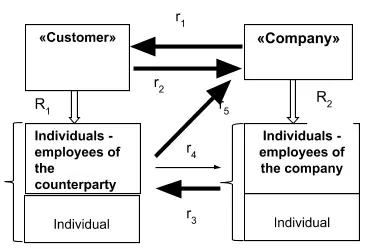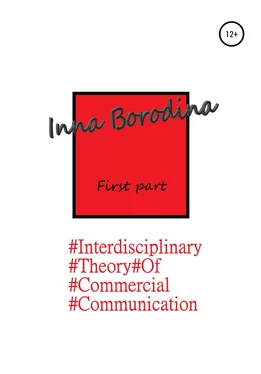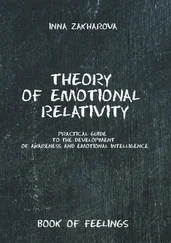Let us dwell in more detail on the conceptual prerequisites of competence, referring to the work of Lingham4, in which he identified areas of competence that are manifested at three levels: organizational, process and individual.
The problem under consideration, due to the specifics of communicative interaction, reflects the change in the state of the participants in communication over time. Thus, the communication interaction of employees-representatives of counterparties is an iterative process in which organizational, professional and individual competencies are involved.
To describe the model of communication interaction between counterparties, a linked type of information interaction between the seller and the consumer of the goods is determined. A linked type of interaction is an interaction in which free interaction leads to feedback. Such a scheme of interaction in the process of communication between contractors allows us to talk about the emergence of an open system of communicative relations. The stronger the interaction between participants, the higher the likelihood of feedback loops.
The parameters of the communication channel, which make it possible to ensure the availability of feedback, are the characteristics of the information transmission channel without interference, and the transfer of the counterparty to the “Customer” category, that is, the repeated purchase of goods, will be a characteristic of the self-organization of communication interactions. Communication costs are actually investments in the long-term capital of consumer preferences. The investment in customer loyalty pays off over a long period of time, and customer goodwill slowly devalues as it slowly gains in the market.
Making a consumer choice, the client motivates his actions by the desire to achieve the marginal utility through the purchase of goods, that is, he implements rational behavior. Consumer preferences in this case can be described by a utility function defined on the set of transaction attributes that have developed in the mind of the employee representing the client.

Fig. 2 – Communication interaction of counterparty.
The consumer's choice is obviously determined by his desire to maximize utility, so he searches not for a product, but for solutions to the problems that a contract can provide.
If there is an equilibrium contract price (a price that satisfies both parties), due to the absence of price influence, it is permissible to use a linear exchange model using the linear programming method similar to that presented in5.
I will dwell on the emerging interactions in more detail (Fig. 2). Interactions of the “Company” side: awareness of the seller's representatives about the subject of the transaction expressed in the form of professional competence (higher than that of the buyer); individual competencies of employees, coinciding with the social dominants supported by representatives of the "Customer".
The “Company” has the advantage of presenting the individual competencies of its employees, fulfilling the expectations of the counterparty at the interpersonal level. Interactions of the “Customer” side: awareness of the subject of the transaction, brand and business reputation of the counterparty (within the limits of professional competence); social awareness of the brand and business reputation (within the framework of individual competence). Representatives of the "Customer", along with business interests, are carriers of public opinion. Schematic solution of the communication interaction of contractors, presented in Fig.2 reflects the influence of professional and personal competences on the decision-making process in favor of concluding a contract when the organizational competence of the seller is satisfactory from the buyer's point of view.
Relationships in the communication process reflect supply and demand: R1, R2 – the impact of the organization's objective on the behavior of employees (organizational competencies); r1 – product price offer and business reputation offer; r2 – is the price demand for the product and the demand for a positive business reputation; r3 – offering the individual and professional competencies of the Company's employees; r4 – offering individual and professional competencies of the "Customer"; r5 – demand for individual and professional competencies of the Company's employees and business reputation. The presence of the r5 connection is a special case of the manifestation of the effect of asymmetric information, and two-fold, and the system under study can be classified as open, with the property of self-organization. The characteristics of the environment are formed by the market awareness of counterparties through various media (branding and other components of marketing communications).
Studying the nature of consumer expectations in the process of concluding a contract, one should pay attention to two main characteristics of the "Customer" that form mutually intersecting sets of consumer expectations. Let's call these sets "individuals" and "corporations", indicating the boundaries of their interaction6.
"Individuals" implement the behavior of an individual consumer seeking to satisfy personal needs. They are guided by such motivational factors that are focused on their own reference group, trying to somehow justify its role expectations, to meet certain social standards. This focus on mass character is realized not only at the conscious level, but also manifests itself on the unconscious, which is monitored by the example of imitative behavior.
This type of behavior is formed through mass communications, while the informational impact is interpreted as a process of intangible production of the value of the goods. In this situation, the “private person” assesses the social component of the brand and business reputation of the partner through interaction at the level of individual and professional competence of employees. Consumer choice in favor of a particular counterparty by a “private person” can be divided into two phases: an effective choice, carried out in the same way by all consumers, and a personal choice of each consumer. In other words, consumer choice is a kind of social need that consists of a set of specific requirements determined by the individual's motivation. When the representatives of the "Customer" implement the model of the individual consumer, the behavioral characteristics fit into the pattern of relationships in the B2C (Business-to-Customers) market.
As David Myers notes, from the perspective of social psychology, all participants in social interaction are subject to prejudice, negative stereotypes and conformism. At the same time, certain behavioral models (“frustration and aggression, the need for status, distinctive features”6) that produce competition ultimately give rise to prejudices. The behavioral model of “attribution error”6 is also interesting, when in the process of interaction, individuals project onto the situation the characteristics of the personality and its status. In fact, objective procedural components are being replaced by personal socio-psychological preferences.
Thus, the "Individual" takes an active part in the search for satisfaction, that is, consumer utility is a finite set. Let's call it "private satisfaction", consisting of several levels of consumer satisfaction.
This is consistent with the conclusions of A.N.Leontyev that any activity based on the initial afferentation excites effector processes that implement contacts with the object environment, and then the image of the object is corrected and enriched with the help of feedbacks of the original afferenting image.
Читать дальше













